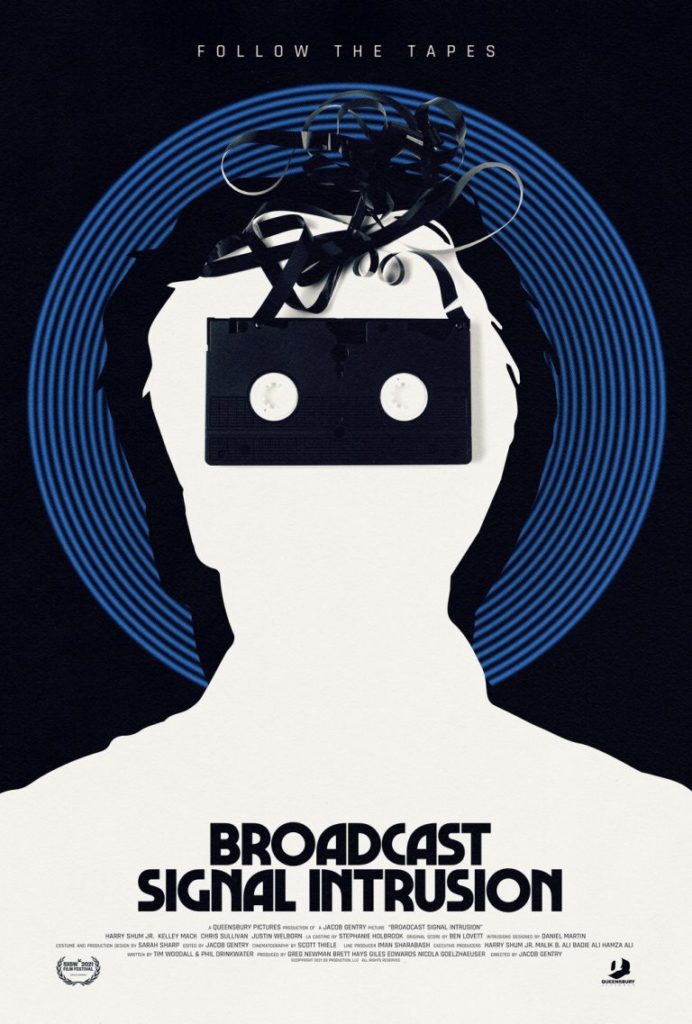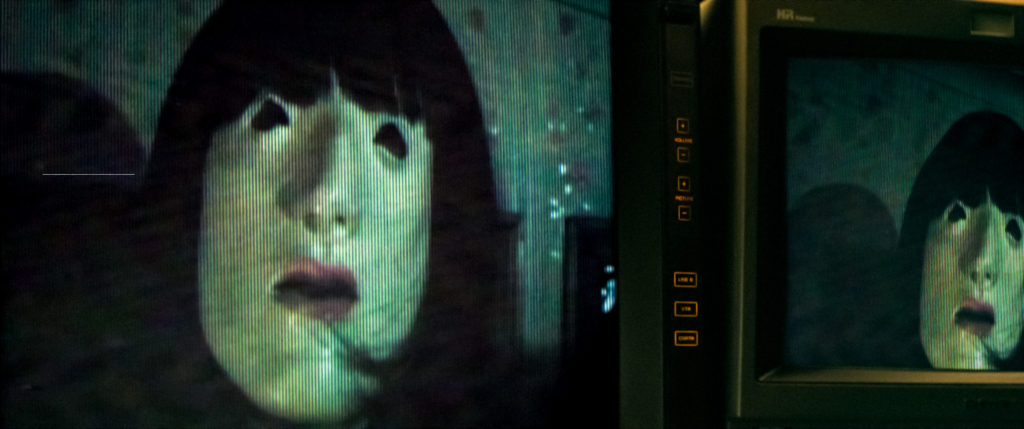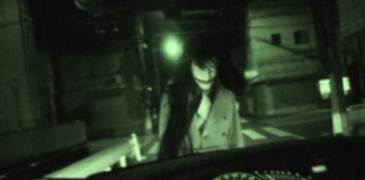
There are very few horror movies that linger in the brain well after viewing, like fine wine on the tongue, dragging your thoughts back over and over to replay it with perplexing clarity. My favorite type of horror movies of this nature are the ones that either require acute focus to unravel “what is happening,” or–better yet–horror movies that present an ending that intentionally obfuscates interpretation. Broadcast Signal Intrusion is one such gem; a delicious morsel to savor and revisit, attempting to break down its many flavors to understand the dish as a whole.
Broadcast signal intrusions were/are a phenomena where an individual or a group hijack a cable or satellite signal in order to show their own content, which is often either political or intentionally disturbing. There have only ever been a handful of them in history, but their impact was still significant on contemporary viewers. In our age of on-demand media, it’s hard to think back on the pre-internet, pre-streaming culture of broadcast television. Programming was near infallible, airing with a strict structure of dates and times, and if you missed a show sometimes it was forever.

When broadcasts were interrupted legitimately, it often meant catastrophic news was on the way, like a bombing, the death of a high profile figure, or a natural disaster (something many BSIs took advantage of to create fake disasters). Pair the conditioning of contemporary audiences to television interruptions with the frequently unsettling nature of BSI visuals, and you can imagine why viewers found them so haunting. Though many broadcast pirates were traced and arrested, and subsequently explained their motives, just as many were never discovered. The mystery of the who and why still hangs over some cases, with an aura of malevolence.
This leads us to the film Broadcast Signal Intrusion. Taking place in 1999, a video archivist named James comes across the recording of a broadcast signal intrusion; a figure in a cheap human-adjacent mask moving erratically, overlaid with layers of discordant audio. The whole effect is incredibly chilling, and one of the strongest features of the film. Harry Chum Jr. plays James, whose wife’s disappearance a few years back was never solved. James begins researching the mystery, learning of and tracking down a copy of the second occurrence of this intrusion, while discovering that there may have been a third incident. When he discovers a possible link of missing women and the timing of the broadcast signal intrusion, and the potential link between his own wife’s disappearance, he is irrevocably drawn into a deep unsolved mystery.
What follows is a man’s descent into an all-consuming obsession, and the closer he gets to the truth the more distorted it may become. A main theme of the film is “coincidence vs correlation,” and once James stumbles upon the missing women theory, his desperation to know the truth may be distorting his judgement. Or maybe not. As the story unfolds things just don’t add up, but James barrels forward regardless. The use of an unreliable narrator paired with contradicting information presents a mind-bending puzzle for the viewer. The film then goes a step further by using every element to cause further chaos; sound effects and the soundtrack often don’t match their scenes, camera shots are distorting or intense when it seems out of place, and characters are never fully explored or explained.

Then comes the end… wowie. Of course I’m not going to describe it to you, but the film continues to defy direct interpretation until the last second. It’s just one of those films that gets better as it goes, and has you running to message boards immediately after viewing and asking what the ending meant. It’s the type of film you will rehash long after watching, playing back scenes and comparing notes, constantly realizing how things just don’t line up. A week after viewing and the pieces make less sense to me now, which makes it all the more (enjoyably) disconcerting.
Much like the South Korean film The Wailing (2016) or the American The Vast of Night (2019), the movie isn’t about a clear answer at the end as to what is going on, but instead about the experience of the journey through the film itself. The very question at the core of the film, “is there a correlation or is it a coincidence?” becomes the very question the viewer must consider when contemplating the information they are given. The most unnerving part of Broadcast Signal Intrusion is that the whole movie we are presented with is turned on its head in the last few seconds, throwing everything we have just seen into disarray. More questions are presented than answers given.
I realize this type of obtuse narrative is not for everyone, but even if it’s not your jam I assure you the film is still worth seeing. With its multiple levels of creep factor and its wonderful utilization of haunting BSI history, horror fans will likely find something to love. Broadcast Signal Intrusion is fun and an ultimately chilling experience that is well worth your time, even if you aren’t the type to hit the message boards immediately after viewing. However, if you do end up on the message boards…. please please tell me what you think happened!
Broadcast Signal Intrusion arrives in UK/EIRE cinemas from 25th March and on Digital Download & Blu-ray from 28th March
courtesy of Lightbulb Film Distribution

More Film Reviews
Established in 2009, the American Genre Film Archive is a non-profit which seeks to collect, conserve and distribute genre films in order to preserve their legacy. From shot-on-video slashers and… Witness protection isn’t enough to keep a mother and her young daughter safe, as the vigilantes hunting them down catch up to the pair. They want a confession the mother… Koji Shiraishi proves his sincerity and devotion to the found footage subgenre in his 2012 low-budget mockumentary Senritsu Kaiki File Kowasugi! File 01 – Operation Capture the Slit-Mouthed Woman. While… My Mother’s Eyes is a 2023 Japanese science fiction psychological thriller, written and directed by Takeshi Kushida. No stranger behind the camera, Kushida is also the creative mind behind the… “We say revenge is like a river, whose bottom is reached only when we drown.” So begins this dark tale of violence steeped in politics and folk horror. A low-budget… Confessions of a Serial Killer is a 1985 American horror thriller, written and directed by Mark Blair. Surprisingly, the film is the only writer/director credit to Mark’s name, never venturing…Sometimes Aunt Martha Does Dreadful Things (1971) Film Review | There’s something about Martha…
Motherly (2021) Film Review – Don’t underestimate a mother’s love
Senritsu Kaiki File Kowasugi File 01: Operation Capture the Slit-Mouthed Woman (2012) Film Review—A Gem Hidden in Plain Sight
My Mother’s Eyes (2023) Film Review – Beyond Sanity [FrightFest]
Saloum (2021) Film Review – Genre-bending Senegalese Horror
Confessions of a Serial Killer (1985) Film Review – I’m Super Cearal

A study in contrasts, Aubry is a lover of knitting and rescuing strays, but also most likely the one cheering loudest during gory horror scenes.
Someday she’s going to get too excited and accidentally stab herself with a knitting needle.



![My Mother’s Eyes (2023) Film Review – Beyond Sanity [FrightFest]](https://www.grimoireofhorror.com/wp-content/uploads/2023/07/My-Mothers-Eyes-cover-photo-365x180.jpg)

